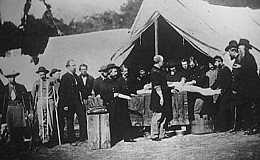Located 15 miles north west of Taneytown, the small town of Gettysburg, Pennsylvania, was the site of the largest American Civil War battle and the largest battle ever waged in the Western Hemisphere. The Battle of Gettysburg opened on July 1, 1863, and closed two days later with the climactic "Pickett's Charge." It resulted in a Union  victory for the Army of the Potomac and successfully turned back the second invasion of the North by General Robert E. Lee's Army of Northern Virginia. Over 51,000 soldiers were killed, wounded or captured making it the bloodiest battle of the Civil War. It was also a major turning point in the war. Historians have referred to the Battle of Gettysburg as the "High Water Mark of the Confederacy." It was the last major effort by Lee to take the fighting out of Virginia and into northern states. The Soldiers' National Cemetery at Gettysburg contains more than 7,000 interments including over 3,500 from the Civil War. It was here that President Abraham Lincoln delivered his immortal Gettysburg Address on November 19, 1863.
victory for the Army of the Potomac and successfully turned back the second invasion of the North by General Robert E. Lee's Army of Northern Virginia. Over 51,000 soldiers were killed, wounded or captured making it the bloodiest battle of the Civil War. It was also a major turning point in the war. Historians have referred to the Battle of Gettysburg as the "High Water Mark of the Confederacy." It was the last major effort by Lee to take the fighting out of Virginia and into northern states. The Soldiers' National Cemetery at Gettysburg contains more than 7,000 interments including over 3,500 from the Civil War. It was here that President Abraham Lincoln delivered his immortal Gettysburg Address on November 19, 1863.
Post-battle preservation efforts saved small portions of the battlefield as a memorial to the Union victory. On February 11, 1895, congressional legislation was signed to establish Gettysburg National Military Park as a memorial dedicated to the armies that fought that great three-day battle. Gettysburg National Military Park incorporates nearly 6,000 acres, with 26 miles of park roads and over 1,400 monuments, markers and memorials.